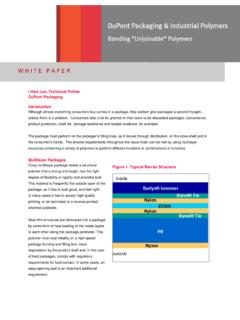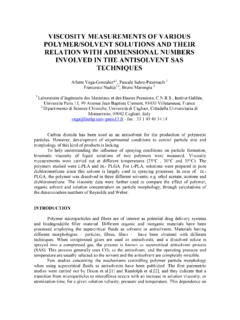Transcription of Mass transfer of water vapor, carbon dioxide and oxygen on ...
1 Mass transfer of water vapor, carbon dioxide and oxygen on modified cellulose fiber-based materials Alemayehu H. Bedane, Qinglin Huang, Huining Xiao and Mladen Ei KEYWORDS: Modified paper , water vapor transmission rate, Gas transmission rate, Relative humidity, Effective diffusivity. SUMMARY: Mass transfer properties of fibre network and coated paper are essential for understanding the barrier properties of the products and further advance in their application. In this study, different unmodified and coated papers, , (Poly lactic acid (PLA), zein grafted paper ) were prepared and characterized with regard to mass transfer properties. water vapor, carbon dioxide (CO2) and oxygen (O2) transmission rates through the cellulose paper films were measured and the results discussed.
2 The effects of sample film thickness and temperature on water vapor transmission rates (WVTR s) were also examined. The WVTR s of the investigated samples were found to be strongly dependent on the temperature and the relative humidity difference (mass transfer driving force). On the other hand water vapor permeabilities (WVP s) were found independent of relative humidity. water vapor diffusivities of the samples were also measured from the uptake rate measurements using Fickian diffusion slab model for a wide range of relative humidities. WVTR s and vapor diffusivity of the modified samples were found to be generally low compared to unmodified (reference) paper sample. Among the investigated samples, PLA/polyhedral oligomeric silsesquioxane POSS-bentonite modified paper sample showed higher mass transfer resistance to water vapour and the gases investigated in this study (CO2 and O2).
3 It showed lower water transmission rate (104 ) compared to PLA-coated paper (130 ), zein coated paper (179 ) and control sample (359 ) at the relative humidity gradient RH=74% and temperature of 25oC. The oxygen transmission rate for PLA/(POSS-Bentonite) coated paper was found to be lower than for the other modified papers. Zein grafted paper showed better barrier property for water vapor than oxygen . water vapor permeation through paper films shows an Arrhenius type of dependency with temperature, indicating activated process. The activation energies reveal diffusion dominated process for all paper samples investigated in this study, according to the solution-diffusion mechanism used to describe the permeation processes.
4 ADDRESSES OF THE AUTHORS: Alemayehu H. Bedane Qinglin Huang Huining Xiao and Mladen Ei University of New Brunswick, Department of Chemical Engineering, Fredericton, NB, E3B 5A3, Canada, Corresponding author: Mladen Ei Chemically-modified wood fibres and fibre networks along with surface treatment of paper play a central role in rendering fibres hydrophobic and oleophobic, which improve barrier properties of the conventional paper products. Cellulose fiber-based materials have been utilized as common packaging materials, substituting plastic materials, because they are considered more environmentally friendly. Biodegradable materials such as starch, poly lactic acid (PLA), corn- zein and cellulose derivatives have been used as common coating materials in order to improve the barrier properties (Jansson et al.)
5 2005; Kugge et al. 2008; Andersson 2008). PLA polymers have acquired increasing attention in the last few years as food packaging materials, because they can be obtained from renewable resources, in addition to being recyclable and compostable. The chemistry of PLA involves the processing and polymerization of lactic acid monomer. This monomer can easily be produced by fermentation of carbohydrate feedstock. The carbohydrate feedstock may be agricultural products such as maize, wheat or alternatively may consist of waste products from agricultural or the food industry (Gupta et al. 2007). Zein is a protein that is derived from corn grains and can also be used as a potential material for the preparation of edible and biodegradable film, because of its hydrophobicity and impermeability to gases (Lawton 2002; Padua, Wang 2002).
6 In packaging industry, the polymer materials are generally required to have low permeability to gases and vapors in particular water vapor. The barrier properties are also crucial for cellulose based packaging materials. Improved surface barrier properties by functional coating require a surface-located layer with minimized penetration of the chemicals into the substrate (Andersson 2008). An improved (increased) barrier property of the packaging material can help to increase the shelf time of foodstuff (Koide et al. 2007; Del Nobile et al. 2006). Besides the high water vapor barrier properties (low permeability), food packaging materials should also have low oxygen permeability (Paine et al. 1992). If the oxygen permeability of the packaging material is too high, this can lead to the development of oxidative reactions that degrades proteins and lipids resulting in spoilage of the food (Robertson 1993).
7 In addition, microorganisms present in the food can start to grow at certain oxygen contents. Mass transfers through food packaging films can occur for any type of material used, if there is a partial pressure difference across the film, even in the case of surface treated multilayer packaging (Lange et al. 2003). Understanding the equilibrium and transport characteristics of water vapor, CO2 and O2 in modified fiber-based materials and coated paper products, is paper PHYSICSN ordic Pulp and paper Research Journal Vol 27 409necessary to improve properties of the fiber-based packaging materials. A number of different experimental methods are available for the measurement of permeability of gases and water vapor through polymer films (Nilsson et al.)
8 1993; Auras et al. 2003; Park et al. 1995; Curtzwiler et al. 2008; Thomas et al. 1998). In this study gravimetric IGA- system is used for accurate and fast measurement of water vapor, CO2 and O2 transmission rates. Gas and vapor transmission rates through a polymer film depend strongly on the temperature and the relative humidity difference (driving force) of the barrier film, and also on the type of coating applied, and thickness of the film. The mass transfer mechanism through a packaging film depends on the porosity of the film. Transport mechanism of water vapor can occur through the void space (pore) or along the fiber cell wall (Bandyopadhyay et al. 2002). Permeation follows solution-diffusion mechanism: the gas first dissolves (adsorbs) at the surface of the material on the high-pressure side, then diffuses through the polymer phase, and finally desorbs or evaporates at the low-pressure side.
9 water vapor transport in the cellulose fiber materials is very important in the application of coating, surface sizing, printing and packaging. There are a few studies available on the measurement of diffusivity on paper surface by using various experimental techniques; however some of the results obtained from different studies vary significantly. For example, Hashemi et al. (1997) reviewed diffusivity results from different literature sources pointing out to the contradictory results; in particular the study was focused on the dependency of diffusivity on moisture content. It is therefore important to understand how textural properties of various cellulose fiber materials, , physically and chemically treated paper can affect gas and water vapor properties, such as diffusion, transmission rate and permeability.
10 The main objectives of this study are to: 1) Measure WVTR s on the selected wood-fibre samples by using different driving force ( RH) in investigations and to analyze the results with regard to potential application for the packaging purposes. 2) Measure the diffusivity of water vapor from uptake rate measurements and analyze the mechanisms of mass transfer of the investigated samples. 3) Measure CO2 and O2 transmission rates through the selected paper samples. Materials and Experimental Materials Several types of paper samples that were prepared for this study are listed in Table 1. Unmodified paper samples were made from pure cellulose with different thickness or densities. Modified paper samples such as PLA-coated paper , PLA/polyhedral oligomeric silsesquioxane (POSS)-bentonite modified paper with coating weight of 20-23 g/m2 and base paper (95 4 g/m2), as well as zein grafted paper (8 corn zein) were preparedaccording to procedures further explained in this section.





